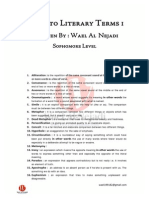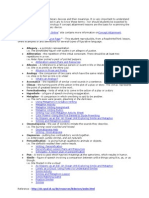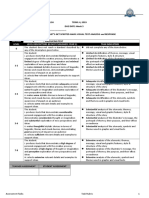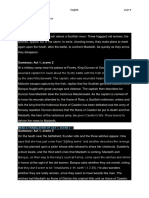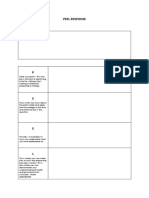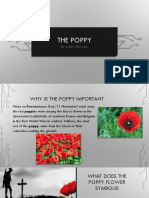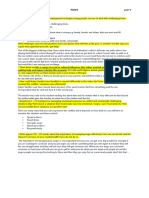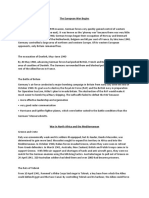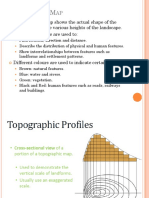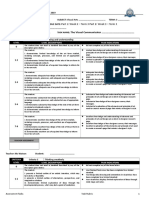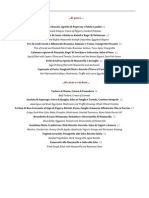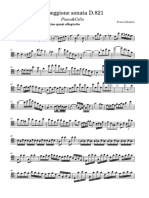Academic English and Literary Terms Australian International Academy, Kellyville Allegory
Uploaded by
api-360153065Academic English and Literary Terms Australian International Academy, Kellyville Allegory
Uploaded by
api-360153065ACADEMIC ENGLISH and LITERARY TERMS
Australian International Academy, Kellyville
Allegory: an extended metaphor wherein the characters, events, and
situations of the story can be taken on two levels: the literal level and the
metaphoric/symbolic level, each thing represents something else.
Ex: Animal Farm
Alliteration: the repetition of beginning sounds in words.
Ex: I rarely rush past red roses.
Allusion: An allusion is a reference to something in history, culture, or literature
(especially historical).
An allusion adds to the depth of our understanding. If we know the reference
then the poet or writer's comparison helps us to see the poem or prose piece
more fully.
Antagonist: the force that works against the protagonist; the antagonist does not have to
be a person (see types of conflicts)
Antithesis: opposition, or contrast of ideas or words in a balanced or parallel construction.
Assonance: The repetition of the same or similar vowel sounds, but with different end
consonants in a line, as in the words, date and fade.
Ballad: a poem that tells a story, usually in four line stanzas with a refrain;
the subject of ballads is generally folk lore or popular legend.
Blank verse: unrhymed iambic pentameter
Climax: the point in the story where the conflict is at its peak, when the conflict has
reached its crisis and one of the two forces "wins."
Conflict: the struggle between two forces, one generally being the protagonist of the
story. The antagonist can be the self, another person, animal, nature,
technology/machine, society, or the supernatural
Connotation: the connotative meaning of the word is the associated meanings that come
from its use in various social contexts. For example: if someone said, "I'm
down with that" in 1955, no one would understand what he/she meant.
Connotative meaning also means the emotional connections to words.
EX: the word test often carries a negative meaning for students.
Australian International Academy, Kellyville Academic English: Literary Terms 1
Consonance: the repetition of consonant sounds at the end of words.
Ex: night, cat, plot
Couplet: two lines of a poem that rhyme; a couplet usually stands as a complete idea or
grammatical "sentence" within the poem.
Denotation: the denotative meaning is the dictionary meaning of the word without its
social connotations.
Diction: diction is the author's choice of words. If she chooses one word over another,
it is probably because that word implies some social or connotative meaning.
Dramatic irony: a discrepancy between what the character knows and what the reader knows
to be true; it's when the reader knows something the character does not know
Dramatic poetry: A composition in verse portraying a story of life or character, usually involving
conflict and emotions, in a plot evolving through action and dialogue.
Dynamic character: a dynamic character is one who changes by the end of the
story, learning something that changes him or her in a permanent
way.
End Rhyme: This is what we call it when the words at the ends of the lines rhyme.
Ex: Line one: The maiden called to me / Line two: As I went out to sea.
Epic poetry: an extended narrative poem that includes heroic or romantic (adventures of
the romantic hero) events or themes.
Ex: The Odyssey
Exact Rhyme: This is when words sound exactly alike.
Ex: cat, hat, rat
Exposition: the background information of a story, the story before the story.
Figurative Language: The general category of language meant to be taken symbolically or
metaphorically, including metaphor, simile, personification, etc.
1st person point of view: the narrator, usually the protagonist, tells the story from his/her
perspective using me, me, us, etc.
Australian International Academy, Kellyville Academic English: Literary Terms 2
Flashback: a strategy of plot sequencing where the author takes the reader back to events
that occurred before the present time in the story.
Flat character: we know very little about a flat character; flat characters are not meant to
serve as main characters. They serve as necessary elements in plot or as
elements of the setting.
Foil: a foil character is either one who is in most ways opposite to the main
character or nearly the same as the main character. The purpose of the foil
character is to emphasize the traits of the main character by comparison or
contrast.
Foot: a two or three syllable unit of meter.
Ex: (U/) is one iambic foot.
Foreshadowing: clues in the writing that lead the reader to predict what will happen later in
the story.
Free verse: lines of poetry that do not have exact patterns, either rhyme, meter or both
Haiku: A Japanese form of poetry, consisting of three unrhymed lines of five, seven
and five syllables. Haiku are very brief descriptions of nature that convey some
implicit insight or essence of a moment. Traditionally, they contain either a
direct or oblique reference to a season.
Hyperbole: exaggeration. The opposite of hyperbole is understatement. By using contrast,
an idea can be emphasized.
Ex: I'm so hungry I could eat a horse.
Iambic Pentameter: A five foot line of iambic meter. This is the most common meter in English.
Imagery: Imagery is language that appeals to the senses. It is description that makes the
reader feel he or she is "in the setting." There are six basic kinds of imagery:
visual (sight), auditory (sound), olfactory (smell), gustatory (taste), tactile
(touch), and kinaesthetic (movement).
Internal Rhyme: Words that rhyme can occur within a line.
Ex: The cat sat on the hat.
Irony: is a difference between what is said and what is meant.
Australian International Academy, Kellyville Academic English: Literary Terms 3
Juxtaposition: placing close together or side by side, esp. for comparison or contrast.
Lyrical poetry: Lyric/lyrical poetry is perhaps the most common; it is that which expresses the
emotional response of the poet to events, people and situations
Metaphor: a comparison of two generally unlike things meant to illuminate truth. Direct
metaphors use "is" to make the comparison explicit. Implied metaphors
suggest the comparison.
Meter: the rhythm created in poetry by the repetition of similar units of sound
patterns (stressed and unstressed syllable combinations): iambic (U/), trochaic
(/U), anapaestic (UU/), dactylic (/UU), spondaic (//), and pyrrhic (UU).
Mood: is the emotional attitude of the author.
Motif: a motif is a recurring image or idea. The repetition of the idea reinforces the
value of the image or idea and usually gets the reader to think about theme.
Narrative poetry: The narration of an event or story, stressing details of plot, incident and action.
Objective point of view: the narrator does not judge or interpret in any way; he/she simply
presents the story as if recording it on film as it happens
Onomatopoeia: words that sound like what they mean.
Ex: "hiss" sounds like the snake.”
Oxymoron: is putting two contradictory words together.
Ex: hot ice, cold fire, wise fool, sad joy, eloquent silence
Parody: A satiric imitation of a work or of an author with the idea of ridiculing the
author, his ideas, or work.
Paradox: reveals a kind of truth which at first seems contradictory. Two opposing ideas.
Ex: Stone walls do not a prison make, Nor iron bars a cage.
Persona: The person created by the author to tell a story.
Ex: Some authors, for example, use narrators who are not very bright in
order to create irony.
Australian International Academy, Kellyville Academic English: Literary Terms 4
Personification: giving human characteristics to non human things in order to give light to
human action, emotion, ideas etc.
Ex: a smiling moon, a jovial sun
Pseudonym: A "false name" or alias used by a writer desiring not to use his or her real
name. Sometimes called a nom de plume or "pen name," pseudonyms have
been popular for several reasons.
Ex: Samuel Clemens used the name Mark Twain
Mary Ann Evans used the name George Eliot
Pun: the usually humorous use of a word in such a way as to suggest two or more of
its meanings or the meaning of another word similar in sound.
Ex: A bicycle can't stand alone because it is two-tired.
Rhyme: The similarity between syllable sounds at the end of two or more lines. Some
kinds of rhyme (also spelled rime) include:
Ex: Couplet: a pair of lines rhyming consecutively:
"These lines make up a couplet with a rhyme.
Just don't expect the lines to be sublime."
Ridicule: The goal is to condemn or criticize by making the thing, idea, or person seem
laughable and ridiculous.
Sarcasm. A form of sneering criticism in which disapproval is often expressed as ironic
praise.
Ex: If you drop your lunch tray and a stranger says, "Well, that was really
intelligent," that's sarcasm. If your girlfriend or boyfriend says it, that's
love--I think.)
Satire. A literary mode based on criticism of people and society through ridicule.
Ridicule, irony, exaggeration, and several other techniques are almost always
present. Many of the techniques of satire are devices of comparison, to show
the similarity or contrast between two things.
Setting: Setting includes time period (such as the 1890's), the place (such as downtown
Warsaw), the historical milieu (such as during the Crimean War), as well as the
social, political, and perhaps even spiritual realities.
Australian International Academy, Kellyville Academic English: Literary Terms 5
Simile: is the comparison of two unlike things using like or as
Ex: He eats like a pig. Vines like golden prisons.
Sonnet: A fourteen line poem, usually in iambic pentameter, with a varied rhyme
scheme.
Ex: The most common rhyme scheme is A-B-B-A A-B-B-A C-D-E C-D-E,
though there is flexibility in the sestet, such as C-D-C D-C-D.
Stanza: is a unified group of lines in poetry.
Style: The manner of expression of a particular writer, produced by choice of words,
grammatical structures, use of literary devices, and all the possible parts of
language use. Some general styles might include scientific, ornate, plain,
emotive. Most writers have their own particular styles.
Symbolism: Something that on the surface is its literal self but which also has another
meaning or even several meanings.
Ex: a sword may be a sword and also symbolize justice. A symbol may be
said to embody an idea.
Tone: The writer's attitude toward his readers and his subject; his mood or moral
view. A writer can be formal, informal, playful, ironic, and especially,
optimistic or pessimistic.
References
Cyber English (2011). Literary Terms. Retrieved 12th April 2011, from:
http://www.tnellen.com/cybereng/lit_terms/
Virtual Salt (2011). Literary Terms. Retrieved 12th April 2011, from:
http://www.virtualsalt.com/litterms.htm
Australian International Academy, Kellyville Academic English: Literary Terms 6
You might also like
- CyberPunk 2020 - Source - Solo of Fortune II (CP3361) (MQ Scan)89% (9)CyberPunk 2020 - Source - Solo of Fortune II (CP3361) (MQ Scan)98 pages
- Level L - Stories of Ourselves - Students Guide 2324 T1W1100% (2)Level L - Stories of Ourselves - Students Guide 2324 T1W135 pages
- Literary Terms - Official List (Alphabetized)No ratings yetLiterary Terms - Official List (Alphabetized)5 pages
- 2324 Level N - Stories of Ourselves - Core - Students GuideNo ratings yet2324 Level N - Stories of Ourselves - Core - Students Guide51 pages
- 2324 - Level N - Stories of Ourselves - Core - Teacher's GuideNo ratings yet2324 - Level N - Stories of Ourselves - Core - Teacher's Guide68 pages
- 11 Grade Honors English Literary Terms: Vocabulary For The Study of LiteratureNo ratings yet11 Grade Honors English Literary Terms: Vocabulary For The Study of Literature5 pages
- Glossary of Selected Literary ConventionsNo ratings yetGlossary of Selected Literary Conventions3 pages
- Literary Terms For Ap English LiteratureNo ratings yetLiterary Terms For Ap English Literature4 pages
- Literary and Rhetorical Terms: Animal Farm Lord of The FliesNo ratings yetLiterary and Rhetorical Terms: Animal Farm Lord of The Flies8 pages
- Major Genres of The 21ST Century LitertatureNo ratings yetMajor Genres of The 21ST Century Litertature32 pages
- GlossaryTemplate - Molina, John Kenneth C.No ratings yetGlossaryTemplate - Molina, John Kenneth C.5 pages
- 2425-Level N - Stories of Ourselves - Core - Student - S Guide T1W1No ratings yet2425-Level N - Stories of Ourselves - Core - Student - S Guide T1W151 pages
- MYP Programme: Criteria Level Level Descriptors (Ib Myp Published: Year 1) Task IndicatorsNo ratings yetMYP Programme: Criteria Level Level Descriptors (Ib Myp Published: Year 1) Task Indicators3 pages
- Assessment Task Sheet: 16 90 Minutes Short Answers and Extended Response (C) Producing Text (D) Using LanguageNo ratings yetAssessment Task Sheet: 16 90 Minutes Short Answers and Extended Response (C) Producing Text (D) Using Language1 page
- MYP Programme: Australian International Academy, Kellyville 2018 Assessment Task RubricNo ratings yetMYP Programme: Australian International Academy, Kellyville 2018 Assessment Task Rubric3 pages
- MYP Programme: Australian International Academy, Kellyville 2018 Assessment Task RubricNo ratings yetMYP Programme: Australian International Academy, Kellyville 2018 Assessment Task Rubric3 pages
- MYP Programme: Australian International Academy, Kellyville Unit Planner 2019No ratings yetMYP Programme: Australian International Academy, Kellyville Unit Planner 201920 pages
- Brainstorm Positive Coping and Management Strategies Young People Can Use To Deal With Challenging TimesNo ratings yetBrainstorm Positive Coping and Management Strategies Young People Can Use To Deal With Challenging Times1 page
- 2019 Assessment Task Year 9 Unit 3 RubricNo ratings yet2019 Assessment Task Year 9 Unit 3 Rubric3 pages
- Prelude 1st Cello Suite Bach M 5c7ec70cbd8dcNo ratings yetPrelude 1st Cello Suite Bach M 5c7ec70cbd8dc4 pages
- English Grammar - LearnEnglish - British Council - Relative ClausesNo ratings yetEnglish Grammar - LearnEnglish - British Council - Relative Clauses8 pages
- High Protein Diet High Fiber Diet Plan-HardikNo ratings yetHigh Protein Diet High Fiber Diet Plan-Hardik9 pages
- Philippine Literature During The Spanish PeriodNo ratings yetPhilippine Literature During The Spanish Period31 pages
- Arpeggione - Sonata - D.821 - Franz - Schubert (2) - ViyolonselNo ratings yetArpeggione - Sonata - D.821 - Franz - Schubert (2) - Viyolonsel14 pages
- CyberPunk 2020 - Source - Solo of Fortune II (CP3361) (MQ Scan)CyberPunk 2020 - Source - Solo of Fortune II (CP3361) (MQ Scan)
- Level L - Stories of Ourselves - Students Guide 2324 T1W1Level L - Stories of Ourselves - Students Guide 2324 T1W1
- 2324 Level N - Stories of Ourselves - Core - Students Guide2324 Level N - Stories of Ourselves - Core - Students Guide
- 2324 - Level N - Stories of Ourselves - Core - Teacher's Guide2324 - Level N - Stories of Ourselves - Core - Teacher's Guide
- 11 Grade Honors English Literary Terms: Vocabulary For The Study of Literature11 Grade Honors English Literary Terms: Vocabulary For The Study of Literature
- Literary and Rhetorical Terms: Animal Farm Lord of The FliesLiterary and Rhetorical Terms: Animal Farm Lord of The Flies
- 2425-Level N - Stories of Ourselves - Core - Student - S Guide T1W12425-Level N - Stories of Ourselves - Core - Student - S Guide T1W1
- Damaged Life: poems after Adorno’s Minima MoraliaFrom EverandDamaged Life: poems after Adorno’s Minima Moralia
- MYP Programme: Criteria Level Level Descriptors (Ib Myp Published: Year 1) Task IndicatorsMYP Programme: Criteria Level Level Descriptors (Ib Myp Published: Year 1) Task Indicators
- Assessment Task Sheet: 16 90 Minutes Short Answers and Extended Response (C) Producing Text (D) Using LanguageAssessment Task Sheet: 16 90 Minutes Short Answers and Extended Response (C) Producing Text (D) Using Language
- MYP Programme: Australian International Academy, Kellyville 2018 Assessment Task RubricMYP Programme: Australian International Academy, Kellyville 2018 Assessment Task Rubric
- MYP Programme: Australian International Academy, Kellyville 2018 Assessment Task RubricMYP Programme: Australian International Academy, Kellyville 2018 Assessment Task Rubric
- MYP Programme: Australian International Academy, Kellyville Unit Planner 2019MYP Programme: Australian International Academy, Kellyville Unit Planner 2019
- Brainstorm Positive Coping and Management Strategies Young People Can Use To Deal With Challenging TimesBrainstorm Positive Coping and Management Strategies Young People Can Use To Deal With Challenging Times
- English Grammar - LearnEnglish - British Council - Relative ClausesEnglish Grammar - LearnEnglish - British Council - Relative Clauses
- Arpeggione - Sonata - D.821 - Franz - Schubert (2) - ViyolonselArpeggione - Sonata - D.821 - Franz - Schubert (2) - Viyolonsel
















